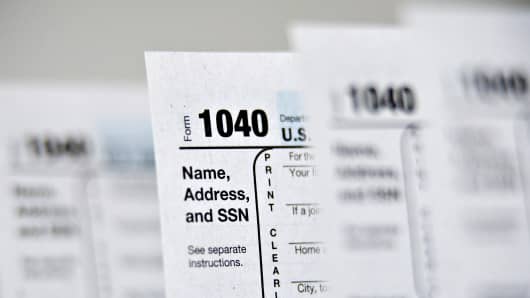President Barack Obama's latest proposal in the "Fiscal Cliff" talks includes an offer to permanently cap the Alternative Minimum Tax, the dreaded levy that snares more middle-income Americans every year.
The proposal doesn't offer specifics on what income levels would be capped, and the Republicans have yet to respond. But the proposal has raised some hopes that millions of Americans could avoid the tax that was first implemented in 1969 to make sure wealthy Americans paid their share of income taxes.
Right now, some 29 million more Americans—in addition to the current 4 million—could be subject to the AMT in their 2012 returns if no agreement is reached on the fiscal cliff. That would include individuals making as little as $33,750 a year and joint filers making $45,000. (Read More: Congress Puts Millions at Risk of 'AMT Shock')
That's because the AMT has never been indexed to inflation, so every year more Americans are caught up in it. Congress has traditionally created patches in years past to keep the AMT from clobbering more taxpayers, but so far no patch has been put up for a vote for tax year 2012.
President Obama's proposal for a permanent patch "is certainly good news if it's done right," said Constance Stone, a certified financial planner in Shagrin Falls, Ohio. "By that I mean it would be something that's inflation adjusted for year to year. The fact that the AMT has not been adjusted for inflation has meant more people have to pay it each year."
More than half of AMT revenue in 2010 came from households with incomes over $200,000, according to the Center on Budget and Policy Priorities. But more upper-middle-income households are being hit than high-end incomes. (Read more: The Rich and Taxes)
"Most people caught up in the AMT fall between the $150,000 to $750,000 salary range, " said Michael Amato, president of Independent Tax Planners in Holland, PA. "Anything above that $700,000 range and you likely owe more in regular tax and pay that instead of the AMT."
And all this talk over patches and fiscal cliff proposals has left taxpayers confused on what to do, said Eleanor Blayney, consumer advocate for the Certified Financial Planner Board of Standards.
"It's just not clear what the patch proposal means and who it would keep out of the AMT," said Blayney. "It's like people have to do several tax returns, with the AMT, without it, and then do their regular taxes as well." (Read more: Estate Tax Also on Hold)
The alarm bells over the patch — or lack of one — have reached the point where the acting commissioner of the IRS sent a letter to Congress last month saying the tax collection agency would need to tell some 60 million taxpayers that they may not file their 2012 tax returns or receive a refund until the IRS makes changes to its system (a patch) and that "they might not be able to file returns until late March of 2013."
The AMT is basically a parallel tax that excludes certain deductions — like state and local income taxes — for people making a certain income level each year. That means taxpayers in AMT brackets have to figure out which tax is more, the AMT or regular taxes — and then pay the higher amount.
AMT rates currently range from 26 percent for singles to 28 percent for married.
The original AMT collected just $122 million — about $700 million in today's dollars — which was just over one-tenth of one percent of all individual income tax revenue. Fast forward to the last tax year of record, 2010, and some $102 billion was collected. (Read more: Super Rich: 'Tax Us When We're Dead')
That's part of the problem when thinking of a patch, permanent or not, said Eleanor Blayney.
"Something has to replace it in terms of helping close the deficit," Blayney said. "It's tough figuring out what can take it's place."
So far, Congressional Republicans have called for ending the AMT completely. While before this most recent fiscal cliff proposal, President Obama said on the campaign trail this past year, that he'd let the AMT go and replace it with the so-called Buffett Tax, a higher tax rate on the very upper income levels.
Meanwhile, the Senate Finance Committee released a proposal on taxes this past August, calling for an increase in the AMT exemption amounts for 2012 to $50,600 (individuals) and $78,750 (married). The proposal would also increase the exemption amounts for 2013 to $51,150 (individuals) and $79,850 (married). But so far, it remains just a proposal.
What planners and taxpayers want in the end is simple, said Constance Stone.
"My clients don't want to pay it. One person called it the alternative maximum tax," said Stone who handles some 60 high and middle income clients.
"What I want is simplicity and consistency. I don't want to have to figure this out for my clients year after year."
--by CNBC.com senior editor Mark Koba
CNBC.com senior editor Deborah Caldwell contributed to this story.



